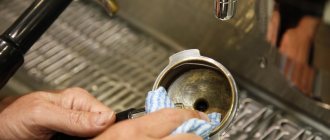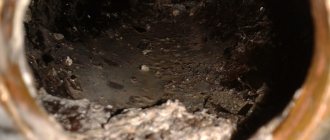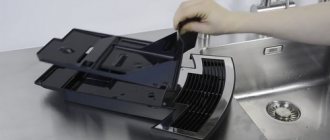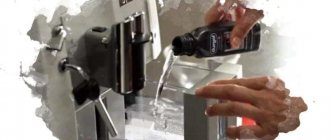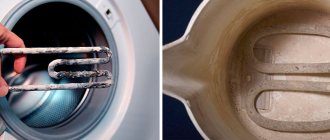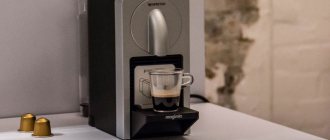Coffee machines have become firmly established in everyday life. They are used in catering, in office kitchens, at home, i.e. almost everywhere. These devices automated all stages of preparing coffee drinks, while ensuring high taste characteristics of the products. But as usual, some problems arise during their operation. One of them is the need to periodically descale the coffee machine or, to use another term, decalcify the coffee machine. This action includes washing machine parts, descaling, etc. All this will be the topic of this article.
Descaling
The main problem that owners of kitchen appliances have to face is the occurrence of scale. In the case of a coffee machine, the heating element of the boiler requires special attention. The cleaning procedure consists of 2 steps (descaling and rinsing) and takes approximately half an hour.
First, you need to drain the liquid from the drip tray, prepare a container with a volume of about 1.2 liters to collect water during the descaling process, remove the additional INTENZA filter from the tank, and also remove the panarello nozzle or cappuccino maker (depending on the model of the coffee machine).
Fill the water tank with Saeco anti-scale agent, add water to the MAX mark and install it in place. Turn off the coffee machine by pressing the button and place a container prepared in advance under the steam/hot water outlet tube. Set disk to coffee bean icon. Press and immediately hold the buttons with the image of coffee cups located in the center of the disk for 5 seconds. After which the reddish indicator should start flashing. The machine will continue to dispense descaling solution into the drip tray. A complete cleaning cycle takes approximately 5 minutes.
After the green indicator turns on, the cleaning agent must be drained from the reservoir. To do this, the disk is moved to the position indicating a hot cup of coffee, and after a minute, liquid will begin to come out through the steam/hot water tube. The whole process will take about 15 minutes. At the end of this cycle, the disc must be placed on the coffee bean icon, drain the water and product from the reservoir and return it to its place.
Fundamentally: all actions are performed with the coffee machine turned off. Otherwise, the coffee making process will begin. If this happens, you need to repeat the actions from the very beginning.
Which cleaning product to choose?
Coffee is a very oily substance by nature. Over time, coffee oils accumulate inside the machine, forming a rancid residue. Cleaning your coffee machine removes residue to keep your coffee fresh.
Expensive models of coffee machines have an indicator indicating when decalcification time has arrived. It does not measure a layer of scale, but a certain number of cups of brewed coffee, after which the machine needs to be cleaned.
Owners of inexpensive coffee machines that do not have such an indicator have to recognize the need for cleaning themselves.
The following signs will let you know it's time to clean your car:
- The espresso machine produces weak, cool coffee with an unpleasant, sour, bitter taste
- coffee takes longer to brew than usual
- At the bottom of the cup after coffee, scale remains in the form of sediment
- The water takes longer to heat up, the coffee flows with difficulty
- The coffee machine is loud and crackling
- electrical energy is consumed more to operate the device
- steam pressure decreases
This means it’s time to give your machine the necessary attention and descale it.
A quick step-by-step video guide to get you started:
Cleaning the coffee machine
Rinse the water tank, fill it with clean water to the highest level and return it to its place. Switch the control dial to the hot water supply position. The inner circuit will fill and the green indicator with the image of 2 cups will light up. Next, move the disk to the image of the coffee bean, and water will begin flowing into the drip tray.
At the end of the process, a greenish indicator with the image of 2 cups will turn on. The disc must be moved to the hot water supply position. From the steam outlet tube, water will begin to combine until the tank is empty. Finish the 1st rinsing cycle by moving the disc to the coffee bean icon, after which the reddish no-water indicator will turn on.
The 2nd cycle begins by filling the tank with the freshest water to the MAX mark. When the green indicator with the image of 2 cups lights up, turn the dial to the hot water position. Water will be connected through the steam outlet tube until the tank is empty. After which the coffee machine will turn off. Next you need to rinse the drip tray and return it to its place. Install the cappuccino maker and INTENZA filter. Wash the water reservoir, fill it and return it to the coffee machine. Start up the coffee making equipment.
How often do you need to descale your espresso coffee machine?
Cleaning your coffee machine from scale helps to avoid many problems. Here are some of them.
- Very noisy noise when making coffee
- Lots of steam when making coffee
- Making coffee takes a very long time
- The coffee machine makes less coffee than usual
- The coffee machine prepares slightly warm coffee
- Every 6 months
Cleaning waste containers
It is imperative to remove waste coffee grounds remaining after brewing. This is usually done at the end of the working day or according to the container full indication on the coffee machine display.
Waste that is not removed promptly can cause mold to form inside the coffee machine, which causes an unpleasant odor and changes in the taste of the coffee. We remove the tray and container from the coffee machine and inspect them.
Please note - literally within 3-4 days mold formed in the container. Similar places for mold to form are the lower tray for collecting system flushing waste, the tray under the cooking unit. You need to carefully monitor this and try to prevent mold from appearing. It is better to throw away waste and wash the trays every day.
How to descale a Philips espresso machine?
What you will need to remove scale:
- To clean drip coffee machines, you can use white vinegar or a special descaling agent CA6700/10, which has a less strong and pungent odor.
- Correct cleaning instructions - Select your Philips espresso machine model below and read the instructions.
7 methods for descaling your coffee machine.
During automatic coffee production, the machine comes into contact with water and a crumbly product that has an oil base. Continuous heating of water and dissolution of coffee particles leads to contamination of the device, the formation of scale, deposits and oil traces. Lack of long-term care has a negative impact on equipment. In the best case scenario, your drink will lose its original taste; in the worst case, the coffee machine will simply break down.
Descalers for coffee machines
To remind the owner of the need for maintenance, some machine manufacturers install a counter for prepared cups of coffee on the screen. If the indicator exceeds a certain limit of 230 cups, it is necessary to service the device. Low frequency of maintenance – 2 times a year, provided that soft water is used. The main enemy of a coffee machine is scale. To get rid of it in time, you can use several effective methods.
Cleaning with decalcifiers
All manufacturers of household appliances recommend using descaling products offered by the same company to descale your coffee machine. This is indicated in any instructions. However, all products are created using the same technology and have a similar composition. They are available in both liquid and tablet form:
- Not everyone can afford to clean a coffee machine using DeLonghi. Branded products are of high quality and guarantee excellent results.
- Cleaning a coffee machine with Saeco descaling agent is cheaper, but it is almost as good in terms of quality.
- Other companies offer their own cleaning products to care for household appliances.
DeLonghi
Saeco
When does a coffee machine need cleaning?
The frequency of cleaning the device depends on the frequency of its use, design features and the water that you pour into the water container. Specific coffee lovers are advised to carefully clean the working parts of the device and carry out preventive maintenance at least once every 2 months. If ordinary tap water is used during all this, cleaning should be done more frequently and carried out monthly.
Coffee machine pills
The presence of scale on the heating elements appears in the form of a small snow-white sediment on the bottom of a cup of coffee. You will be able to see that the machine has started to operate louder and the water stream from the drink outlet has become narrower. In addition, there may be an increase in energy consumption and coffee preparation time.
On some machines from the Delonghi, Philips, Nespresso and Saeco brands, the cleaning indicator on the device panel may glow. All of these signs indicate that your home appliances need care. Delaying maintenance may result in device failure.
How do you know when it’s time to clean your coffee machine?
Many modern and more advanced coffee machines have a special sensor. It cannot recognize scale, but it can count how many cups of coffee you have prepared (if the coffee machine is designed to be cleaned after 250 cups, then after preparing them it will light up). And yes, if the sensor lights up, you don’t need to pull the cat by the tail and put off cleaning, otherwise the coffee machine may simply refuse to brew coffee for you. If you do not have such a sensor, pay attention to these signs:
- the coffee began to smell unpleasant;
- The taste may also change - it will be undercooked or not strong enough;
- steam pressure dropped significantly;
- The coffee machine began to make strange sounds when operating that you had not noticed before.
Cleaning frequency
On average, the need for cleaning arises after the machine has prepared about 200 servings of coffee or once every 1-3 months, taking into account the frequency of operation of the machine and the hardness of the water used for making coffee.
Depending on the model, some devices are equipped with special sensors, and they themselves inform you when cleaning is necessary.
The following factors may also indicate the need to remove deposits:
there is a whitish sediment in the prepared drink;- during operation, the device emits an uncharacteristic hum;
- there is a drop in steam pressure;
- whipping milk foam for a long time and its weak fluffiness;
- The coffee stream becomes thinner than before.
If warning signs indicating scale build-up appear, it is advisable to carry out cleaning immediately.
Methods for cleaning coffee machines
The use of one or another method depends on the brand of coffee machine, the existing difficulty and the manufacturer’s advice. A new device always comes with an annotation that contains tips and precautions for using the device. Study them to get basic information on servicing your coffee machine. In the user’s arsenal there may be a purchased product and folk methods aimed at working with machines of a certain type.
Delonghi Nespresso capsule coffee machine
Self-cleaning
Certain types of devices are supplied with an integrated self-cleaning function. Typically, these are devices with a removable teapot and cappuccino maker, which naturally become clogged, even if they are not used often. By pressing the dedicated "clean" button, you can provide preventative care. With all this, do not forget to fill the water container and place a deep glass under the nozzle, which will prevent water from splashing.
Descaling agent for coffee machine
Many manufacturers produce a line of products created for specific models. For example, a Delonghi, Philips, Nespresso and Saeco brand coffee machine is cleaned with pills of the same name, watery additives and powders. To remove scale, use powder or pill.
Manual cleaning of the device
The instructions for some devices do not indicate the use of a special tool. Typically, self-cleaning devices also do not completely remove plaque, so the manual method can also be used for them. Buy a universal product in powder form, pour it into the coffee compartment and press the button to make a drink. This simple method will free the multifunctional parts of the machine not only from scale, but also from oily deposits.
Cleaning the cappuccino maker
A coffee machine with a cappuccino maker requires careful maintenance. It must be washed immediately after use, since scale, organic particles of milk and coffee settle tightly on the walls of the device. It is best to immediately use self-cleaning and expel ordinary water through the system. You can achieve the final result only after clear water begins to fill the glass.
Pills as a ready-made solution for scale
Coffee machines from the Philips, Saeco, Nespresso and Delonghi brands are cleaned with pills produced by the manufacturers of these machines themselves. For quick cleaning, you need to place 1-2 pills in accordance with the instructions in the coffee brewing compartment. Then you press the drink making button and run the system until the pills are completely dissolved.
Citric acid instead of powder
If you don’t have a comprehensive coffee machine cleaning product on hand, you can use a universal folk method. Fill the water tank with warm water with dissolved citric acid (2-6 tablespoons). Then pour the liquid into the water compartment. Start making the drink and monitor the result. Citric acid is completely replaceable with vinegar (1/3 solution) or alcohol (half a glass per liter of water).
Coca-Cola as an enemy of scale
Pour a bottle of carbonated drink into the water compartment and run the entire volume through the coffee machine. After the procedure, you must thoroughly wash the inside with ordinary water.
Is it worth using traditional methods?
When deciding how to clean a coffee machine, you should remember the so-called traditional methods for descaling at home. In principle, you can save a little and clean your car from various salt and other deposits with such cheap and affordable products as vinegar or citric acid, since they are almost always available in the kitchen. In addition, branded liquids or tablets contain the same citric acid. But at the same time, unlike industrial products, it is easier to make a mistake in the proportions and not get the desired result, or even harm the machine. Therefore, if possible, it is better not to experiment with such products. Although it is useful to understand how to use them, so that in case of emergency (for example, if it is impossible to buy a special product), you can use them effectively without damaging the car.
Can I use citric acid?
Regular citric acid can be used for decalcification. This is a food product that, when reacting with lime deposits, leads to detachment and removal of lime deposits.
Cleaning procedure:
- Remove waste. Wash removable elements with water.
- Separately prepare a solution of 8 teaspoons of citric acid for each liter of water.
- Stir until the acid grains dissolve.
- Pour the resulting solution into the water tank.
- Leave to stand for several hours.
- After at least 2 hours, start the coffee brewing cycle. Whether or not to add coffee for this depends, as when cleaning with professional products, on the type of coffee machine.
- Drain the liquid.
- Rinse the tank.
Cleaning liquid with coffee should not be used in food.
The video will show you how to descale a coffee machine using citric acid:
How to descale a coffee machine with citric acid
Manufacturers offer a variety of descalers, but they are all quite expensive, and limescale must be removed every month. Large companies such as DeLonghi, Philips, Bosh produce branded cleaning products for their household appliances. You can find universal cleaners on sale, both liquid and tablets.
You cannot use descaling compounds designed to remove deposits from the surface of gas stoves or sinks; this will lead to damage to the machine. The main active ingredient in most branded products is citric acid. Many coffee machine owners have been cleaning their equipment themselves for years using a citric acid solution without causing harm to their equipment.
Citric acid has a number of undoubted advantages:
- safety for human health and the environment;
- efficiency, it removes even old scale;
- no toxic fumes when heated;
- accessibility, it is in any home;
- low price.
All this explains the popularity of citric acid as a cleaning agent for household appliances.
The main cleaning steps are the same as when using a store-bought product:
- filling the reservoir with cleaning solution;
- cleaning process;
- removal of cleaning solution;
- thorough washing.
Let's take a closer look at how to clean a coffee machine using home remedies; the instructions for servicing household appliances will help us with this.
Descaling
The main stages of descaling are the same for different types of coffee machines. It is necessary to strictly adhere to the instructions, only instead of using a special product, use citric acid, having previously diluted it in water.
If you haven’t cleaned your coffee machine for a long time and a solid layer of scale has formed, dissolve 50-100 g of citric acid in one liter of water. If you care for your household appliance regularly, a 30% solution is sufficient (proportions: 30 g of acid per 1 liter of water).
Sequencing:
- Prepare a solution, stir until the acid is completely dissolved.
- Fill the reservoir up to the mark indicating the maximum amount of liquid possible.
- Insert the container with the solution into the coffee machine and carry out the cleaning procedure, following the instructions. If your equipment does not have an automatic cleaning function, pour in the solution, wait a quarter of an hour, turn on the device by selecting the “coffee preparation” function.
- Turn off, remove the reservoir, pour out the remaining solution, rinse.
Almost all modern models have a scale formation indicator; if you do not have such a function, descale the coffee machine with citric acid every 1-2 months, depending on the frequency of use of the household appliance and the hardness of the water.
First rinse cycle
To prevent residual citric acid from spoiling the taste of coffee, the coffee machine must be rinsed thoroughly:
Fill the tank with clean water to the maximum level, install it in the machine, select the “coffee preparation” function without adding coffee powder. The first rinse will take you 3-5 minutes.
Second rinse cycle
To completely get rid of citric acid, rinse the tank thoroughly, fill it with clean water, and repeat the “coffee preparation” mode without adding coffee itself. This completes the procedure for cleaning the coffee machine with citric acid, and the scale has been removed.
Features of car care for various brands
It doesn't matter which coffee machine requires a personal touch. For example, descaling a Delonghi coffee machine is carried out with care products from this brand. Do not forget to remove waste water and coffee from the trays and try to use purified water to extend the life of the device.
Descaling a Saeco coffee machine can be done comprehensively using pills. You can place not 1, but 2 pills in the tank to increase the cleaning efficiency. This type of descaling of a Philips coffee machine is done with powder solutions and pills. More detailed tips on caring for your coffee machine can be found in the instructions for a particular device.
Saeco Xsmall Automatic coffee machine.
What are the consequences if you don’t clean it?
If descaling is not carried out at the specified time, parts may be damaged by corrosion.
The drinks themselves created by the coffee machine begin to lose their taste. In this case, the drink not only acquires an unpleasant aftertaste, but can also be harmful to health. This is due to the fact that lime deposits create a favorable environment for the development of pathogens.
At the same time, the thermal conductivity of the heating element deteriorates, the components begin to malfunction, and their functionality is impaired. As a result, the coffee machine itself begins to work worse, and the drink becomes less and less tasty. Over time, the device will require expensive repairs.
Find out which descaling procedure is suitable for your Xsmall coffee machine model.
The descaling procedure depends on the model number and serial number of the coffee machine.
The model number and serial number are located on a label on the inside of the service door.
Model number: HD8743–HD8747 and RI8743–RI8747 with serial number TW901241438213–TW901434485351. Descaling procedure for Xsmall version 1.
Model number: HD8743–HD8747 and RI8743–RI8747 with serial number less than TW901241438213 or greater than TW901434485351. Descaling procedure for Xsmall version 2.
Model number: HD8644–HD8647. Descaling procedure for Xsmall version 3.
Model number: HD8642–HD8643. Descaling procedure for Xsmall version 4.
Before descaling
The descaling procedure takes approximately 30 minutes and consists of scrubbing and rinsing cycles. Once you start the descaling function, you need to finish it.
Getting Started
- Drain the drip tray.
- Prepare a container to catch water during the descaling process.
- Remove the INTENZA+ water filter from the water tank (if equipped).
- Remove the panarello / cappuccino maker / automatic cappuccino maker (if equipped).
Devices with self-cleaning function
For “smart devices” that themselves let the user know that it’s time to clean, the following work should be performed:
Prepare a solution (strictly according to the instructions for the selected product).- The prepared liquid is poured into a tank intended for water.
- The waste container is cleaned and coffee residues are removed.
- The automatic cleaning cycle starts. In this case, you should follow all the prompts of the device itself (for example, clean the tray, add water, etc.).
You should not interfere with the operation of the device during the self-cleaning period.
Xsmall descaling procedure 1
Model number: HD8743–HD8747 and RI8743–RI8747 with serial number TW901241438213–TW901434485351.
The started function must be completed to the end without interrupting the process. Unplugging the coffee machine will not cancel the process. If the descaling function cannot be completed, unplug the coffee machine, set the control dial to the “BEAN” position and TURN ON the machine by pressing the ON/OFF button. The machine will automatically resume the descaling function from step 6. Continue and complete the function.
Descaling
1) Empty the water tank and fill it with Philips/Saeco descaling solution. Fill with fresh water up to the MAX mark and place the tank back. 2) TURN OFF the coffee machine by pressing the ON/OFF button. 3) Turn the control dial to the “GRAIN” position. 4) Place a large container under the steam/hot water wand. 5) Immediately press and hold the ESPRESSO and COFFEE buttons for 5 seconds. The reddish EXCLAMATION symbol will begin to flash rapidly and will continue to flash throughout the descaling cycle. 6) The machine will dispense descaling solution into the drip tray at minute intervals. The liquid does not come from the steam/hot water wand. This will take about 5 minutes. Wait until the green “2 CUPS” indicator lights up.
Please note: If you do not turn the coffee machine OFF before pressing the buttons, it will start brewing coffee instead of starting the descaling cycle. If this works, repeat the steps starting from step 2.
7) When the greenish “2 CUPS” indicator lights up, turn the control dial to the HOT WATER position. After approximately 1 minute, liquid will begin to flow from the steam/hot water wand at minute intervals until the tank is empty. This will take about 15 minutes. 9) When the greenish “2 CUPS” indicator begins to flash slowly, turn the dial to the “GRAIN” position. The reddish LOW WATER indicator will light up. 10) Drain the large container and drip tray and replace them.
Flushing cycle
11) Rinse the water tank and fill it with fresh water up to the MAX line. Install it in your car. 12) When the greenish “2 CUPS” indicator lights up, turn the control dial to the HOT WATER position. The machine will fill the inner contour. 13) After which the greenish “2 CUPS” indicator will begin to flash slowly. Turn the control dial to the “GRAIN” position. 14) The machine will start dispensing water into the drip tray. The liquid does not come from the steam/hot water wand. 15) When the greenish “2 CUPS” indicator lights up, turn the control dial to the HOT WATER position. Then water will be supplied from the steam/hot water wand until the tank is empty. 16) After which the greenish “2 CUPS” indicator will begin to flash slowly. Turn the control dial to the “GRAIN” position. The reddish LOW WATER indicator will light up.
2nd washing cycle.
17) Drain the large container and drip tray and replace them. 18) Rinse the water tank and fill it with fresh water up to the MAX line. Install it in your car. 19) When the greenish “2 CUPS” indicator lights up, turn the control dial to the HOT WATER position. 20) The steam/hot water wand will supply water until the tank is empty. 21) Then the coffee machine will turn off. The reddish EXCLAMATION symbol will go out. Turn the control dial to the “GRAIN” position. 22) Rinse the drip tray and replace it. Reinstall the pannarello/cappuccino maker and INTENZA+ filter (if applicable). 23) Rinse the water tank and fill it with fresh water up to the MAX line. Install it in your car. 24) Turn on the coffee machine to make coffee.
Cleaning the cappuccino maker of automatic coffee machines
Dairy machines with automatic cappuccino makers come with a built-in jug and a discharge tube. Cleaning cappuccino makers is very important. Dried milk is a favorable environment for the proliferation of bacteria, mold growth, and milk can also clog tubes. The milk frother must be cleaned regularly after each use with a special product. Cleaning is carried out in disassembled form. If you do not clean it, the milk tube may become clogged and will not produce foam well.
Each manufacturer produces its own product. Unbranded analogues are also present.
At home, you can prepare a substitute for cleaning products. To do this, you need to dilute one tablespoon of baking soda in a liter of warm water. Pour the prepared soda solution into a bowl, disassemble the cappuccino maker, soak it in the solution for a couple of hours, then rinse with water. The automatic milk frother can also be washed in the dishwasher.
Cleaning algorithm:
- Place water instead of milk and turn on the cappuccino mode. Continue cleaning until the water becomes clear.
- Rinse the jug under running water or in the dishwasher.
- Special liquid or tablet products for dairy systems will be useful.
Xsmall 2 descaling procedure
Model number: HD8743–HD8747 and RI8743–RI8747 with serial number less than TW901241438213 or greater than TW901434485351.
Descaling:
1) Make sure the unit is ON and the control dial is in the center “GRAIN” position. 2) Empty the water tank and fill it with Philips/Saeco descaling solution. Fill with fresh water up to the MAX mark and place the tank back. 3) Place a large container under the steam/hot water wand. 4) Turn the control dial to the HOT WATER position and pour out 2-3 cups of water (about 150 ml). Stop the water flow by turning the dial to the “GRAIN” position. 5) Wait approximately 10 minutes for the product to take effect. 6) Turn the control dial to the HOT WATER position and pour out 2-3 cups of water (about 150 ml). Stop the water flow by turning the dial to the “GRAIN” position. 7) Wait approximately 3 minutes for the product to take effect. Repeat steps 6 and 7 until the descaling solution in the tank runs out and the LACK OF WATER indicator glows steadily.
1st washing cycle.
9) When the NO WATER indicator stays steady, move the dial back to the “GRAIN” position. Rinse the water tank and fill it with fresh water up to the MAX line. 10) Drain the liquid from the container and place it again under the steam/hot water outlet pipe. 11) Turn the control dial to the HOT WATER position. The machine's rinse cycle will begin. Wait until all the water from the tank has been drained and the LACK OF WATER indicator lights up steadily. 12) Turn the control dial to the “GRAIN” position.
2nd washing cycle.
13) Rinse the water tank and fill it with fresh water up to the MAX line. Drain the liquid from the container and place it again under the steam outlet tube. 14) Place a cup under the spout and brew one serving of coffee. Press and release the ESPRESSO button. The coffee making process will begin. Wait until the drink is ready and remove the cup. 15) Place a container under the steam/hot water wand. 16) Turn the control dial to the HOT WATER position. Wait until all the water from the tank has been drained and the LACK OF WATER indicator lights up steadily. 17) Turn the control dial to the “GRAIN” position. 18) Rinse the drip tray and replace it. Reinstall the pannarello/cappuccino maker and INTENZA+ filter (if applicable). 19) Rinse the water tank and fill it with fresh water up to the MAX line. Install it in your car.
Cleaners
Coffee maker manufacturers such as Philips Saeco, Bosch, DeLonghi, Jura, Melitta, Krups, etc. offer branded anti-scale products. In fact, all these companies do not produce the products themselves, but rather contract companies. They are called OEMs (companies that copy existing products). One brand's proprietary product is also suitable for another brand.
Universal products can be used in any automatic coffee machine. These are Top House, Urnex, Topperr, Philips-Saeco, Delonghi, Swipl, WPRO, Melitta Anti calc, Bubble Ice, Kumkumit and others.
Of the branded products, Bosch and Melitta brands are the cheapest. The products can be found at hardware stores or hardware stores. When using, do not exceed the proportions indicated in the package.
Tablets, powders, or liquid descalers are all about equally effective, although the price may vary. Before starting the cleaning process, tablets and powders must be completely dissolved. The water tank is filled to the maximum level.
All special products contain acids (maleic, citric and sulfamic), baking soda to remove contaminants and a corrosion inhibitor. They must not include toxic substances. The means are written CALC; descaling; decalcifier and can be recognized by these inscriptions.
- Powdered universal decalcifiers and coffee oil removers. The powder is dissolved in water and poured into a water tank. The proportion is indicated in the instructions. In addition to cleaning, they protect against corrosion.
- Liquid cleaning products are poured into the water container to the fullest. Therefore, their application is simple.
Exceeding the proportions and improper cleaning will cause the coffee machine to fail.
Xsmall 3 descaling procedure
Model number: HD8644–HD8647 with control dial.
1) TURN OFF the coffee machine. 2) Drain the drip tray and replace it. 3) Empty the water tank and fill it with Philips/Saeco descaling solution. Fill with fresh water up to the MAX mark and place the tank back. 4) Place a large container under the steam/water outlet pipe. 5) Move the control dial to the center “GRAIN” position. 6) Immediately press and hold the ESPRESSO and COFFEE buttons for 5 seconds. The machine will begin dispensing descaling liquid into the drip tray at minute intervals. The liquid does not come from the steam/hot water wand. This will take about 5 minutes. The descaling indicator will slowly flash orange until the cleaning cycle is completely completed.
7) When the greenish 2 CUPS indicator lights up steadily, turn the control dial to the HOT WATER SUPPLY position. After approximately 1 minute, liquid will begin to flow from the steam/hot water wand at minute intervals until the tank is empty. This will take about 15 minutes. When the greenish 2 CUPS indicator begins to flash slowly, move the dial to the center “BEAN” position. The 2 CUPS indicator will go out, and the reddish LACK OF WATER indicator will light up. 9) Remove and clean the container and drip tray, then replace them. 10) Remove the water tank, rinse it and fill it with fresh water to the MAX line. Install it in your car. 11) When the greenish 2 CUPS indicator lights up steadily, turn the control dial to the HOT WATER SUPPLY position. The machine will begin the process of filling the circuit. 12) When the greenish 2 CUPS indicator begins to flash slowly, move the dial to the center “GRAIN” position. The machine will start dispensing water into the drip tray. The liquid does not come from the steam/hot water wand. 13) When the greenish 2 CUPS indicator lights up steadily, turn the control dial to the HOT WATER SUPPLY position. Liquid will begin to flow through the steam/water outlet tube. 14) At the end of the rinsing cycle, the orange DESCALING indicator will go out and the EXCLAMATION symbol will start flashing. Move the control dial to the center “GRAIN” position. 15) The green STANDBY indicator will start flashing. The machine will heat up and automatically perform a rinsing cycle. 16) The device is ready for use.
Xsmall 4 descaling procedure
Model number: HD8644–HD8647 without control dial.
- TURN OFF the coffee machine.
- Drain the drip tray and replace it.
- Empty the water tank and fill it with the full amount of Philips/Saeco descaling solution. Fill with fresh water up to the MAX mark and place the tank back.
- Place a large container under the coffee spout.
- Press and hold the ESPRESSO button for 5 seconds. The DESCALING indicator will slowly flash orange until the descaling cycle is completely completed.
- The machine will dispense descaling liquid through the coffee spout at minute intervals until the water tank is empty. This will take about 20 minutes.
- When the red NO WATER indicator lights up, remove and clean the container and drip tray, then replace them.
- Remove the water tank, rinse it and fill it with fresh water to the MAX line. Install it in your car.
- The machine will start dispensing water through the coffee spout. During the entire rinsing cycle, the DESCALING indicator flashes orange twice.
- At the end of the rinsing cycle, the DESCAL CLEAN indicator will go out and the STANDBY MODE indicator will begin to flash green. The machine will heat up and automatically perform a rinsing cycle.
- The machine is ready for use.
The information on this page applies to models: HD8642/01, HD8644/01, HD8646/01, CA6700/99, CA6700/00, CA6702/00, HD8743/19, HD8745/09, HD8745/19, HD8747/09, RI9743/ 11, RI9745/01. more less
Instructions for use Philips Saeco Xsmall HD8743.
Philips coffee machine - instructions for choosing
When planning to purchase expensive equipment for the office, you should immediately determine a number of parameters by which the choice will be made. In addition to color and case size, there are other differences in the model line.
- The volume of the water tank should be optimal for the number of employees. The taste preferences of coffee lovers are also taken into account, so that everyone can brew themselves a cup of their favorite drink.
- Lovers of lush milk foam will need a cappuccino maker. It can be operated manually, semi-automatically or prepare cappuccino at the touch of a button.
- The latest models are equipped with much more electronics and dispense up to five different types of coffee at the touch of a button.
Many people know how to use a Philips coffee machine. It is quite clear and easy to use. However, you should treat it very carefully and carefully follow the instructions written individually for each device.
